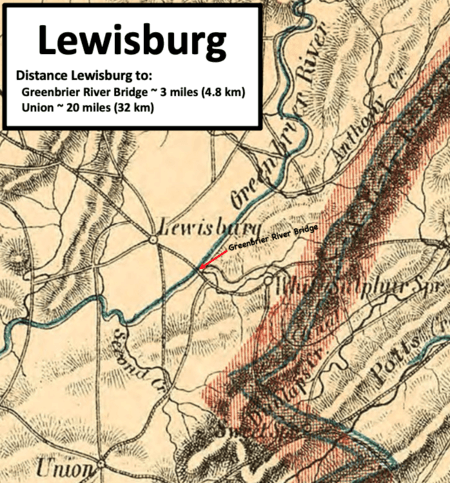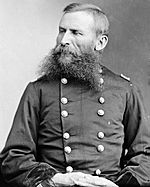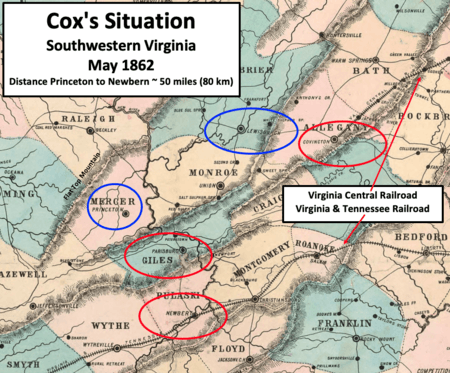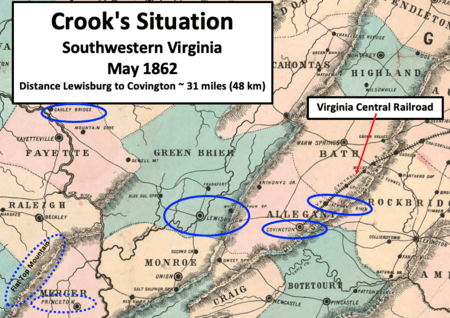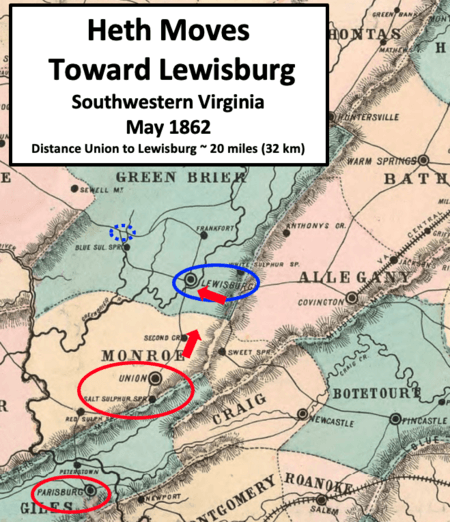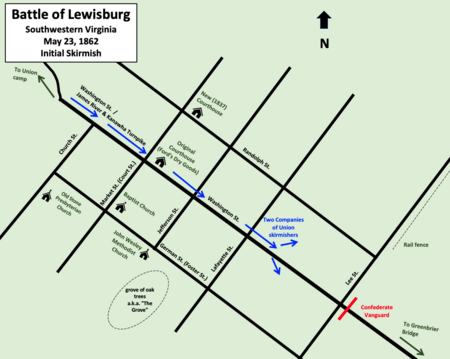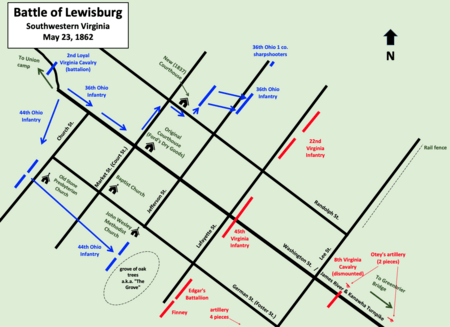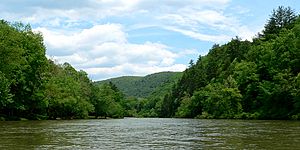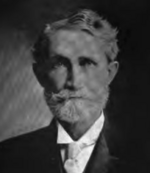Battle of Lewisburg facts for kids
Quick facts for kids Battle of Lewisburg |
|||||||
|---|---|---|---|---|---|---|---|
| Part of the American Civil War | |||||||
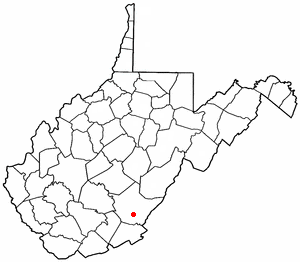 Lewisburg in Greenbrier County, West Virginia |
|||||||
|
|||||||
| Belligerents | |||||||
| Commanders and leaders | |||||||
| Units involved | |||||||
|
3rd Provisional Brigade |
Army of New River
|
||||||
| Strength | |||||||
| ~ 1,400 | ~ 2,300 | ||||||
| Casualties and losses | |||||||
| 93 (19 dead, 66 wounded, 8 missing) | 240 (64 dead, 86 wounded, 90 missing) | ||||||
The Battle of Lewisburg was a fight during the American Civil War. It happened in Greenbrier County, Virginia (now part of West Virginia). On May 23, 1862, a Union group led by Colonel George Crook won a big victory. They defeated a larger Confederate force. This Confederate force was led by Brigadier General Henry Heth. The panicked Confederate soldiers ran away. They crossed a bridge over the Greenbrier River and then burned it.
Before the battle, Colonel Crook's Union soldiers were in Lewisburg. Most people there supported the Confederacy. A larger Confederate force, led by General Heth, attacked early in the morning. Heth thought it would be an easy win. Crook sent two small groups of soldiers, called skirmishers, to meet Heth's attackers. These two groups fought briefly and then pulled back. Heth thought the whole Union army was running away. So, he sent all his soldiers forward, including his cannons.
But Crook had placed his foot soldiers on both sides of the town. Soon, the Confederates found themselves surrounded on the sides and had to flee. General Heth lost at least four cannons during the battle. More cannons were lost near the Greenbrier River Bridge. Many of his men dropped their weapons and supplies as they ran. Union cavalry (soldiers on horseback) and foot soldiers chased them. Crook's unexpected win led to him being promoted to brigadier general. Heth and a group of new soldiers were blamed for the loss.
Contents
Why the Battle Happened
The state of Virginia decided to leave the United States on May 23, 1861. It then joined other southern states to form the Confederate States of America. However, many people in the western part of Virginia wanted to stay loyal to the United States. They formed their own state, which officially became West Virginia on June 20, 1863. In the southern part of western Virginia, people from the mountains often supported the Union. But most people in the big valleys supported the Confederacy. Groups called bushwhackers and partisan rangers used surprise attacks. They fought to control the area.
Lewisburg was the main town in Greenbrier County since 1778. The town supported the Confederacy. Bushwhackers used it as a base for their operations. The town is in a small valley, with hills on its east and west sides. In 1862, about 700 people lived there. Lewisburg was important because two main roads crossed there. Washington Street, part of the James River and Kanawha Turnpike, went east-west. Eastward, it led to the Shenandoah Valley and a railroad at Covington, Virginia. Westward, it led to the Kanawha River Valley and Charleston. The Huntersville Turnpike went north-south. These roads and railroads were key for moving soldiers and supplies for the Confederacy.
The Armies Involved
Union Army
The Union's Mountain Department was created in March 1862. It covered western Virginia and parts of Tennessee and Kentucky. Major General John C. Frémont was in charge. Within this department, Brigadier General Jacob Dolson Cox led the Kanawha Division. This division was responsible for the western Virginia area where the Battle of Lewisburg happened. Cox's division had three brigades. The one in this battle was the Third Provisional Brigade. It was led by Colonel George Crook.
Crook was a professional soldier. He graduated from the United States Military Academy (West Point) in 1852. His brigade had three groups of foot soldiers. Their main camp was at Meadow Bluff, about 18 miles (29 km) northwest of Lewisburg. Crook reported that 1,200 of his foot soldiers fought in the battle. Other sources say the number was higher, around 1,400.
Here are the main Union groups at Lewisburg:
- The 36th Ohio Infantry Regiment was led by Lieutenant Colonel Melvin Clarke. This group had nine companies. They all used powerful Enfield rifles. This was their first major battle.
- The 44th Ohio Infantry Regiment was led by Colonel Samuel A. Gilbert. This group had some fighting experience from late 1861.
- The 2nd Loyal Virginia Cavalry Regiment (later 2nd West Virginia Cavalry) was led by Colonel William M. Bolles. Only one group, called a battalion, was with Crook. This battalion had five companies. They used sabers, pistols, and some had shortened Enfield rifles.
Confederate Army
In May 1862, the Confederate Army in western Virginia was part of the Department of Southwest Virginia. Major General William W. Loring was its commander. General Henry Heth reported to Loring. Heth was also a West Point graduate and an experienced soldier. Heth called his group the Army of New River. For the battle, his force had two experienced groups of foot soldiers. It also had a small group of cavalry, a group of cavalry fighting on foot, and an inexperienced group of foot soldiers. Including his cannon operators, Heth had about 2,300 men.
Here are the main Confederate groups:
- The 22nd Virginia Infantry Regiment was led by Lieutenant Colonel George S. Patton.
- The 45th Virginia Infantry Regiment was led by Colonel William Henry Browne.
- Edgar's Battalion (also called 26th Virginia Infantry Battalion) was led by Lieutenant Colonel William W. Finney. Major George Edgar helped organize this group. Many of these men were new and had poor weapons, like squirrel rifles.
- The 8th Virginia Cavalry Regiment had about 200 men, some on horses and some on foot.
- Heth had eight to ten cannons. These came from different artillery groups.
Before the Battle
The Union's plan was to attack Confederates in Knoxville, Tennessee. First, General Cox's division was to move south. They would try to stop the Virginia and Tennessee Railroad. This railroad was a key link for Confederate armies. Once the railroad was stopped, Cox would move west to join other Union groups. This plan started in early May. Cox and two of his brigades moved to Flat Top Mountain. But then Cox learned the attack on Knoxville was canceled. This was because of Confederate Major General Thomas "Stonewall" Jackson's movements. Cox still decided to attack the Virginia and Tennessee Railroad.
Cox Moves South
From Flat Top Mountain, Cox took control of Princeton. Cox planned to attack further south with his First and Second brigades. He hoped to reach the Virginia and Tennessee Railroad at Dublin Depot. His 23rd Ohio Infantry Regiment occupied Pearisburg starting May 6. But Confederate Brigadier General Heth arrived on May 10 with a larger force. This made the 23rd Ohio pull back towards Princeton after some fighting.
On May 15, Confederate forces started fighting again with Cox's brigades. After a surprise attack near Princeton caused over 90 Union casualties, the fighting stopped. Cox worried about Confederate forces coming from many directions. So, he pulled back to Flat Top Mountain. This fighting became known as the Battle of Princeton Courthouse. It is seen as a Confederate victory.
Crook Moves East
On May 11, Crook sent soldiers to capture Lewisburg. They drove out the small Confederate force there. The Union cavalry then left, but the foot soldiers stayed in town during the day. They camped on a hill outside town at night. On May 15, Crook arrived with most of his brigade, including the cavalry.
The next day, Crook's brigade moved east to White Sulphur Springs. He planned to capture supplies belonging to Confederate General Heth. As they moved, Crook learned that a group of Confederate guerrillas, the Moccasin Rangers, were nearby. Crook's advance group of 12 cavalrymen surprised some of them. They captured about 30 Moccasin Rangers.
Crook's brigade reached the Jackson River Depot on May 17. They learned that Confederate troops had already fled with Heth's supplies. Crook found out that Stonewall Jackson was sending troops to Covington. Crook also received an order to return to Lewisburg to help General Cox. To slow down any Confederate troops arriving by train, a railroad bridge was burned. Crook's trip back began the next morning. He arrived in Lewisburg on the evening of May 19.
Heth Moves Toward Lewisburg
After what he called the "rout of Cox's army," Heth moved his force toward Lewisburg. On May 21, he was 24 miles (39 km) from Lewisburg. He knew he had more soldiers than the Union troops in Lewisburg. He felt sure he could make a surprise attack and win. However, Crook already knew Heth was nearby. Union cavalry on a scouting mission found Heth and reported back to Crook. This made Crook warn Cox and start getting ready.
Crook had all supplies loaded into wagons. He sent some soldiers west on the main road. They would meet up with another Union group. Union guards were placed on all roads leading to Lewisburg. This included near the Greenbrier River Bridge. Lewisburg was about 3 miles (5 km) west of the bridge. The main Union camp was another mile (1.6 km) west of town.
Heth left Salt Sulphur Springs at 5:00 am on May 22. He moved through the town of Union. That evening, he camped about 2 miles (3 km) from the Greenbrier River Bridge. Guards were placed between the camp and the bridge. Campfires were not allowed. The long covered bridge is now in Caldwell, West Virginia.
The Battle on May 23
At 4:00 am on May 23, Heth's men continued moving to Lewisburg. Union guards at the Greenbrier River Bridge were pushed back, captured, or killed. This was done by Confederate cavalry. Two cannons were left on a hill near the bridge. The main part of Heth's force continued to Lewisburg. They were led by a few cavalrymen. They came from the east and pushed back a second group of Union guards. Heth placed his men on Lewisburg's eastern hill. Edgar's Battalion was on the left, the 45th Virginia Infantry in the middle, and the 22nd Virginia Infantry on the right. Cook's group of cavalry fighting on foot was kept in reserve. The main force arrived on the eastern hill shortly after sunrise.
The Union camp, on the hill west of town, heard the wake-up call at 4:15 am. As the men gathered, they heard gunshots from the east. Minutes later, Crook got a report that Union guards had been attacked. He quickly ordered a small force to check. Captain Lysander W. Tulleys led Company D from the 44th Ohio Infantry. Company G from the 36th Ohio Infantry followed. These two companies moved into town on the main road. Some locals teased them, saying Confederates would take over the town. The two companies moved forward in the morning fog. In town, they approached what they thought were Union guards. Instead, they were met with a burst of enemy musket fire.
Heth thought he had surprised Crook. He also believed he was fighting Crook's smallest group of soldiers. He thought the rest of Crook's force was retreating into the hills. But the only Union soldiers in the hills were supply wagons and a cavalry group kept in reserve. After the surprise gunfire, the two Union companies slowly pulled back. Heth started firing his cannons at the Union camp. As Heth watched the two Union companies retreat, he ordered his foot soldiers and cannons forward. This was despite his cannon leaders' protests. Crook's supply wagons leaving and his cavalry moving up the hill made Heth think Crook was retreating. The Confederate soldiers moved down the eastern hill, chasing the two Union companies. The people of the town cheered them on.
Crook's Soldiers Attack
While the two Union companies were fighting, Crook rode into town. He wanted to see the enemy's positions. When he returned, he led the 44th Ohio Infantry into town. They spread out on the Union right side of town. Crook left Colonel Gilbert in charge. Then, Crook rode back to the 36th Ohio Infantry. He placed them on the left side of town. The land helped hide the two Union groups from the enemy. The groups could not see each other because of houses in the middle of town. The two companies of skirmishers held off Heth's men for at least 20 minutes. Then they rejoined their main groups.
44th Ohio Infantry
Colonel Gilbert's 44th Ohio moved toward the enemy on the Union right. His men were in two lines. As they moved, Confederate cannon fire flew over their heads. They faced two Confederate groups on the far left. These were led by Lieutenant Colonel Finney and Major Edgar. More than half of the Confederate cannons were behind Finney and Edgar.
Gilbert's men were hidden and surprised Finney and Edgar's inexperienced soldiers. These Confederates were caught in an open wheat field. The Union soldiers fired many shots at the unprotected Confederates. The Confederates ran away after Finney's group was attacked from the side. Major Edgar was also badly wounded. Gilbert's men then focused on the enemy cannons. They used rifle fire and bayonet charges. They captured most of a cannon group and killed about 20 men protecting it. They also took prisoners and captured about 200 small firearms.
36th Ohio Infantry
The Union 36th Ohio faced the Confederate 22nd Virginia on the Union left. Moving uphill, the Union soldiers met the Confederates who were behind a fence. As the fight began, the Union soldiers found that their rifles could shoot farther than the Confederate smooth-bore muskets. After a strong fight, the Union soldiers got within 40 yards (37 m) of the enemy line. This made the Confederate soldiers retreat.
For the 36th Ohio, the fight lasted about 20 minutes. Some soldiers fought from among the houses in the town center. By 6:30 am, the nine companies of the Union group reached the top of the town's eastern hill. For the Confederates, this was the first time the 22nd Virginia Infantry had ever retreated. Their retreat happened shortly after Finney and Edgar's Battalion retreated on the other end of the Confederate line.
Heth Retreats
At the start of the fighting, Cook's cavalry (fighting on foot) had been kept in reserve. Heth now called on them to stop Finney and Edgar's retreat. But this did not work. Finney and Edgar's men kept running toward the Greenbrier Bridge.
With both ends of the Confederate line retreating, the 45th Virginia Infantry was left alone in the middle. The two Union groups started firing at the Virginians. This meant the 45th Virginia was being shot at from two sides. As the Confederates started to fall back, one of two cannons near the main road was captured. Heth and other officers tried to get the men to fight again. But soon, the entire Confederate force was running for the Greenbrier Bridge.
The Chase and End of Battle
Both Union foot soldier groups reached the town's eastern hill. But most of the men did not chase Heth's men much farther. They were afraid of a trap. One company from the 44th Ohio and two companies from the 36th Ohio continued the chase. They got close to the Greenbrier Bridge. After the 44th Ohio captured four cannons, Crook sent the 2nd Loyal Virginia Cavalry after Heth's retreating men. The cavalry started 1 mile (1.6 km) from the Confederate line. But Heth's men were long gone by then. The road to the Greenbrier Bridge and nearby fields were covered with many Confederate muskets, cartridge boxes, knapsacks, blankets, and jackets. These were left behind by Heth's fleeing men.
When the cavalry reached the Greenbrier Bridge, they found it burning. All Confederates were on the other side. Two to four more Confederate cannons were damaged and left in the river. The battle had lasted only 90 minutes. The main fighting by Crook's two foot soldier groups lasted only 20 minutes. Crook carefully ordered his men to return to camp. Small groups of cavalry began to patrol every road to Lewisburg. This was to prevent a Confederate surprise attack. Heth and his men continued their retreat. They went to Union in Monroe County, and then further south.
Soldiers Lost
A study by historian Richard L. Armstrong lists 93 Union soldiers lost. Nineteen died, 66 were wounded, and 8 were missing. Crook's men buried 13 of their own near Lewisburg. Union losses included Colonel Crook himself. He was wounded in the foot, but kept leading his soldiers. Crook's report on May 24 said 11 Union soldiers were killed and 54 wounded. He also said some town citizens shot at wounded soldiers, killing one. Plans were made to punish these people if they could be caught.
Armstrong's study of Confederate losses totals 240. He believes this number is likely low because old records are hard to find. Thirty Confederates were killed, and 86 were wounded. Ninety men were missing or captured. Edgar's Battalion and the 22nd Virginia Infantry had almost 200 of the losses. The 45th Virginia Infantry had fewer losses. This was because they fought among the houses in the middle of town. Crook's report said Finney, Edgar, some officers, and 93 regular soldiers were captured. He also said he had 66 wounded prisoners and 38 dead Confederates. He captured 4 cannons. Heth's report did not list losses, only saying "the loss of many a brave officer."
What Happened After
Battle's Effect
Private Joseph Sutton, a historian for the 2nd Loyal (West) Virginia Cavalry, called the battle "one of the best planned little engagements of the war." He thought Crook tricked Heth into town. Heth was surprised to find Union foot soldiers on both sides of his army. Then the Union army chased the panicked Confederates out of town. Heth described the battle as "a most disgraceful retreat." He blamed his groups for having new soldiers and new officers. But he also said he should take some blame for the disaster. Historian Armstrong says Heth "totally mismanaged the entire affair." One mistake was putting cannons too close to the front. They were supported by an inexperienced group (Edgar's). Another problem was Heth's order that made Edgar's group cross an open wheat field. There, Union soldiers hidden among trees attacked them.
Crook was later promoted to brigadier general by Cox. He later became the commander of the Army of West Virginia. In the years that followed, William Tecumseh Sherman called him America's "greatest Indian fighting General." Crook later became a supporter of Native American civil rights. Heth was also promoted later. He led a brigade in the Army of Northern Virginia. He is most famous for an action that started the Battle of Gettysburg. This was against Confederate General Robert E. Lee's order to avoid fighting. Edgar's Battalion fought in the Battle of Lewisburg just three days after they joined the army. Because they fought poorly, the 22nd Virginia Infantry Regiment refused to march with them. But the battalion later improved. They fought well at the Battle of White Sulphur Springs in 1863.
Preserving the History
Much of the fighting happened near the town's streets. So, there is no preserved battlefield. However, some of the buildings and cemeteries still exist. The John A. North House was built in 1820. It is now a museum. It was added to the National Register of Historic Places in 1974. The Confederate Cemetery at Lewisburg has 95 unknown Confederate soldiers. They died in the Battle of Lewisburg and the Battle of Droop Mountain. It was added to the National Register in 1988. There is a small Union cemetery near Lewisburg, but it is on private land.
Lewisburg's Old Stone Presbyterian Church is another building on the National Register of Historic Places. During the Civil War, it was used as a hospital for both sides. Some Confederate soldiers who died in the Lewisburg battle were first buried there. Later, they were moved to the Confederate Cemetery. The John Wesley United Methodist Church was hit by a cannonball during the battle. Old ammunition and shell casings were later found under the church floor. In 1974, when the church was added to the National Register, you could still see where the cannonball hit.


